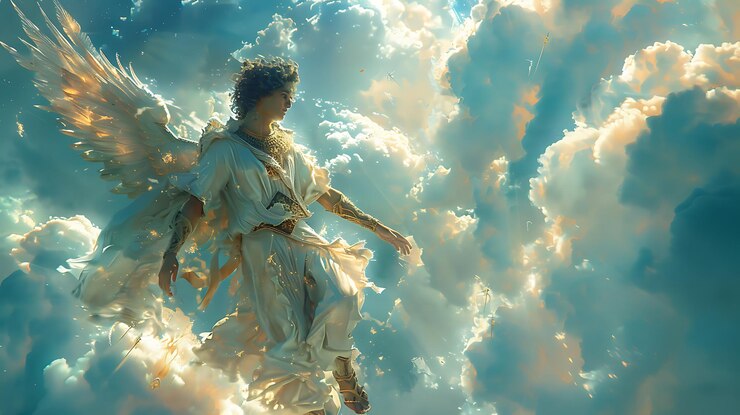Cherubim have long captured the imagination of people across cultures and centuries. These majestic beings, often depicted with angelic features, serve as guardians of both heaven and earth. But what exactly are cherubim? Their presence can be felt in ancient texts, religious practices, art, and modern interpretations alike. This blog post will delve deep into the fascinating world of cherubim—exploring their origins, roles in various faiths, symbolic meanings, and lasting influence on culture. Whether you’re a history buff or simply curious about these celestial figures, prepare for an enlightening journey through time!
What Is cherubim?
Cherubim are intriguing celestial beings often depicted in religious texts and artwork. Traditionally, they possess a dual nature, embodying both divine guardianship and innocent playfulness.
These beings are frequently described as having multiple wings, sometimes with the faces of humans or animals. This complex imagery signifies their multifaceted role in spiritual realms.
In various cultures, cherubim serve as messengers between heaven and earth. They act as protectors of sacred spaces and knowledge. Their presence is believed to bring comfort and guidance to those who seek it.
The concept of cherubim transcends mere physical form; they symbolize deeper truths about existence. They remind us of the connection between humanity and the divine mystery that surrounds us.
Ancient Depictions and Beliefs about Cherubim
Ancient cultures viewed cherubim in varied and intriguing ways. In Babylonian mythology, these celestial beings were depicted as winged creatures with human heads, often guarding sacred spaces and treasures. Their presence symbolized divine protection.
In the Hebrew Bible, cherubim are described as having multiple wings and faces that could represent different aspects of creation. They served as guardians of the Garden of Eden, tasked with preventing access to the Tree of Life after Adam and Eve’s fall.
Egyptian art also embraced similar forms. Winged deities adorned tombs and temples, signifying a protective role for the deceased on their journey to the afterlife.
Across these ancient civilizations, cherubim embodied a bridge between heaven and earth—a manifestation of divine will intertwined with human fate. Such beliefs shaped how societies understood spirituality and protection through symbols rich in meaning.
The Role of Cherubim in Different Religions
Cherubim hold a fascinating position across various religions. In Christianity, they are often depicted as celestial beings guarding the throne of God. Their presence signifies divine glory and wisdom.
In Judaism, cherubim are mentioned in the Hebrew Bible as protectors of sacred spaces. They adorn the Ark of the Covenant, symbolizing God’s covenant with His people.
Islam also recognizes these magnificent creatures, referring to them as angels who serve specific roles within Allah’s creation. They convey messages and maintain order in the universe.
Each religion weaves its own narrative around cherubim. Despite differences, their essence remains similar—guardianship and divine connection resonate throughout spiritual traditions worldwide. This shared theme emphasizes their significance beyond mere symbolism; they embody deeper connections to faith and spirituality across cultures.
Symbolism and Meaning of Cherubim
Cherubim are rich in symbolism, often representing divine wisdom and protection. These celestial beings serve as guardians, bridging the gap between heaven and earth.
Their multiple wings signify swiftness and their ability to transcend dimensions. In many traditions, cherubim are viewed as messengers of God, conveying important revelations.
The imagery of cherubim frequently appears in sacred texts and art, embodying purity and enlightenment. Their presence brings a sense of comfort, reminding believers that they are watched over by higher powers.
Additionally, cherubim symbolize innocence and joy. Often depicted with childlike features, they evoke feelings of love and serenity amidst chaos.
In various cultures, these figures inspire hope while serving as reminders of the spiritual realm’s influence on our lives. Cherubim remain integral symbols of faith across different societies throughout history.
Modern Interpretations and Depictions of Cherubim
Modern interpretations of cherubim have taken on various forms across art, literature, and pop culture. Often depicted as innocent, chubby children with wings, these representations differ significantly from their ancient counterparts.
In contemporary art, artists explore deeper symbolism. are sometimes portrayed as guardians or protectors rather than mere symbols of innocence. This shift reflects our evolving understanding of spirituality.
Literature also embraces the concept of in fantasy genres. They appear as enigmatic beings that bridge the gap between heaven and earth, drawing on both biblical roots and imaginative storytelling.
Film and television frequently utilize cherubic imagery to evoke emotion or divine presence. Their winged forms often symbolize hope amidst turmoil.
These modern depictions capture a blend of reverence and creativity, ensuring that cherubim remain relevant in today’s cultural landscape while continuing to inspire awe.
The Influence of Cherubim in Art and Culture
Cherubim have long captured the imagination of artists and storytellers alike. Their ethereal presence often symbolizes divine protection and purity in various artworks throughout history.
In Renaissance art, frequently adorned ceilings and altars, embodying a connection between heaven and earth. Artists like Raphael infused their works with chubby-faced angels that evoked innocence. These depictions became iconic representations of celestial beings.
Literature also reflects the fascination with. Writers use them to symbolize grace or to convey deeper spiritual themes within narratives. They appear in poetry as messengers bridging the gap between humanity and the divine.
Modern interpretations continue this legacy, appearing in popular culture from movies to graphic novels. Cherubim are often depicted as whimsical figures but still carry an air of mystique, reminding us of their ancient origins and significance across cultures worldwide.
Conclusion: The Enduring Presence of Cherubim in Our World
The presence of cherubim resonates deeply throughout various cultures and belief systems. These celestial beings, often depicted as guardians, signify protection and divine guidance. From ancient texts to modern interpretations, the image of the continues to captivate our imagination.
Their role spans across religions, each attributing unique meanings and symbolism to these magnificent entities. Whether viewed as protectors of sacred spaces or symbols of divine love, cherubim hold a significant place in spiritual narratives.
Modern art and literature continue to explore their essence, reflecting society’s enduring fascination with these ethereal figures. As we navigate through life’s complexities, the concept of serves as a reminder of the unseen forces that watch over us.
Cherubim transcend simple classification; they embody hope and assurance in times of uncertainty. Their influence persists not only within religious contexts but also permeates everyday cultural expressions, ensuring that their legacy remains vibrant in the contemporary world. are more than just mythological creatures—they represent an everlasting connection between heaven and earth.










